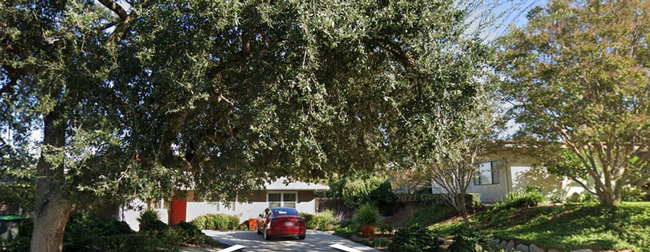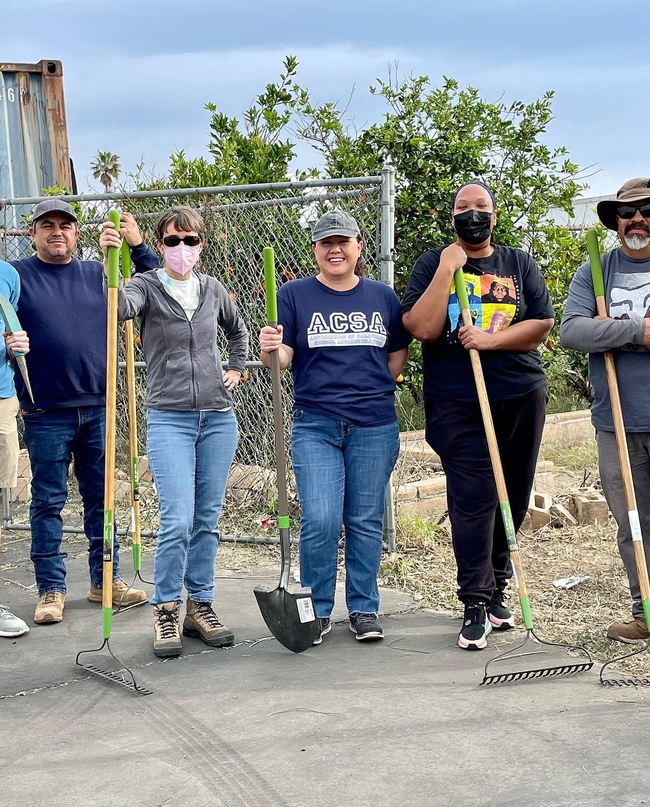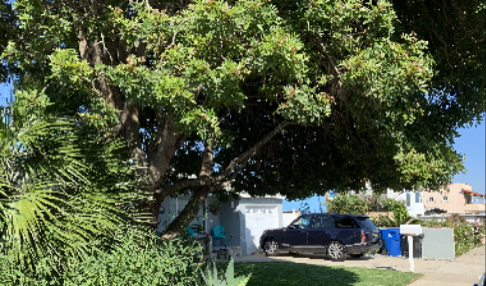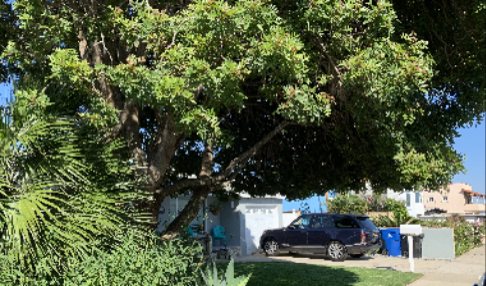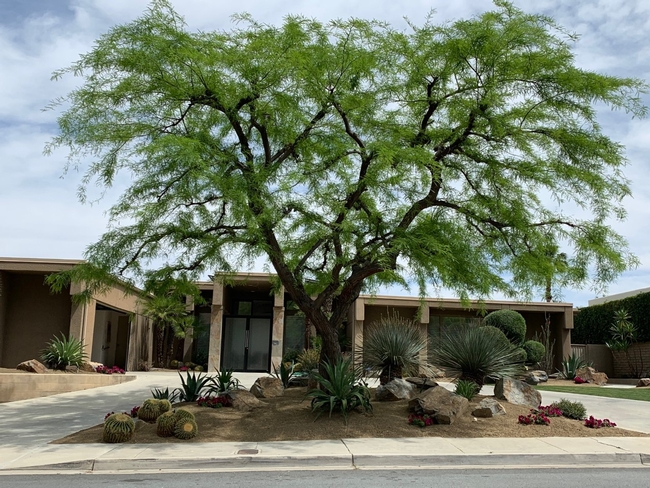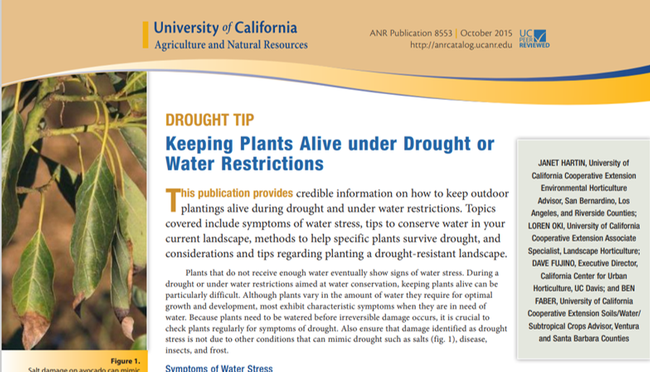Posts Tagged: water use
Drought Resources for Keeping Trees Alive
University of California Cooperative Extension Drought Resources To Keep Your Plants Alive
"Trees Come First Under Drought and Water Restrictions"
Keeping Plants Alive Under Drought and Water Restrictions (English) https://anrcatalog.ucanr.edu/pdf/8553.pdf
Keeping Plants Alive Under Drought and Water Restrictions (Spanish) https://anrcatalog.ucanr.edu/pdf/8628.pdf
Prioritizing Trees During Drought and Water Restrictions (5 minute Youtube)
https://www.youtube.com/watch?v=CTKLlJgdLVk
Tips to Keep Your Landscape Trees Alive Under Drought https://ucanr.edu/b/~IjC
Landscape Tree Irrigation to Maximize Tree Health, Benefits, and Beauty https://ucanr.edu/b/~YjA
Landscape Tree Irrigation 101 https://ucanr.edu/b/~UjA
Top 10 Ways to Conserve Water in Your Landscape and Garden https://ucanr.edu/b/~tTD
Asphalt and Synthetic Turf are Superheating our Cities (in Desert Sun newspaper) https://www.desertsun.com/story/opinion/contributors/valley-voice/2022/04/09/coachella-valleys-asphalt-synthetic-lawn-heat-islands-reach-170/9515857002/
Use of Graywater in Urban Landscapes in California https://anrcatalog.ucanr.edu/pdf/8536.pdf
Need More Help? Speak to a UC Cooperative Extension Master Gardener in Your County of Residence.
Find email and phone helplines here: Find a UC Master Gardener Program - UC Master Gardener Program (ucanr.edu)The Top Ten Ways to Conserve Water in Your Landscape and Garden in San Bernardino County
1. Select drought-resistant plants that grow well in your climate zone and microclimate (sun, shade, etc.). Try these search engines:
SelecTree: A Tree Selection Guide (calpoly.edu) Plant Search Database
Plant Search Database - Water Use Classification of Landscape Species (WUCOLS IV) (ucanr.edu)
For inland San Bernardino County: Home - Inland Valley Garden Planner
2. ‘Hydrozone': Place plants with similar water needs (very low, low, medium, high) together and water the hydrozones on different valves (or, if hand watering, water plants requiring the most water longer but not necessarily more often than other plants).
3. Make sure your irrigation system is operating properly (pressure, spacing, no weeds around heads, no broken parts, etc.).
4. Irrigate based on species and seasonal water needs (highest in summer) and soil type (sandy loam, clay loam, etc.).
5. Irrigate slightly below the current root zone depth of your plants to encourage deep rooting into cooler soil: - 6”-8” for annuals, perennials, and turf - 8”- 1' for shrubs - 1' or deeper for trees
6. Water early in the morning when soil evaporation is minimal.
7. Control weeds. They compete with your garden plants for water.
8. Spread and maintain 2-4” of mulch around garden plants and trees (3-4” for wood chips, 2” for pebbles, decomposed gravel, etc.) keeping it a few inches away from tree trunks.
9. Avoid over-fertilizing. Too much nitrogen creates weak growth and the need for more water.
10. If you have a lawn and still want to keep it, water based on the UC ANR 'Lawn Watering Guide': http://ucanr.org/freepubs/docs/8044.pdf
Contact a trained University of California Cooperative Extension (UCCE) Master Gardener in San Bernardino County for more help! mgsanbern@ucanr.edu (fastest!) or: (909)387-2182 (leave a message for a return phone call)
Redlands trees
Tips to Keep Your Landscape Plants Alive During Drought
In your landscape, your trees and edibles should come first under drought and water restrictions! If there just isn't enough water to go around, your lawn and flowers should be sacrificed instead. Trees are our most valuable landscape resource and take years to maximize their benefits (shade, cooling, habitat/ecosystem enhancement, carbon dioxide storage, energy conservation, pollution filters, etc.).
Just a few slow, deep waterings with a garden hose away from the trunk and slightly beyond the drip line will keep established trees alive, even during summer. Remember to keep trunks dry!
Here are some other tips:
• Spread and maintain 2-4” of mulch around garden plants and trees (3-4” for wood chips, 2” for pebbles, decomposed gravel, etc.) keeping it a few inches away from tree trunks. (Note: dark colored dyed mulches should be avoided in inland and desert areas due to their high surface temperatures that can > 60 degrees F hotter than living plants and lighter colored mulches.)
• Water early in the morning when soil evaporation is minimal.
• Control weeds. They compete with other plants for water.
• Avoid fertilizing. Nitrogen increases growth and the need for more water.
• Don't plant new plants during the summer when temperatures are highest. Even drought-resistant native and non-native plants need regular watering their first season.
Trees Come First During the Drought!
During the drought, your trees should come first! Because many well-maintained trees don't reach their prime until their 4th or 5th decade, it's important to keep them watered during the drought and water restrictions. Older trees absorb higher levels of carbon dioxide, do a better job of cooling urban heat islands and providing shade. They also filter air and water pollutants, reduce soil and water erosion, provide habitat for wildlife, enhance privacy, beautify neighborhoods and parks, enhance property values, and even improve mental and emotional health. Trees are worth saving! The price of starting over is just too steep.
Recognizing early signs of drought stress is important because irreversible damage can occur that no amount of watering will correct. If you cash in your grass for a water district rebate, remember to water any trees that relied on water from the lawn sprinklers. This is because tree roots grow laterally quite a distance, often well beyond the dripline of the tree under the lawn. Over time, start watering them more deeply and less often to encourage deeper roots and enhanced stability.
Just a few deep waterings in mornings or late evenings with a garden hose during spring and summer can keep a tree alive, even during a drought. Keep the trunk dry and water from the mid-dripline outward. Apply a slow steady stream of water, moving the hose to another section of the tree every 1-2 hours. Another inexpensive way to water your trees is to encircle them with soaker hoses that connect to a garden hose. The soaker hose should be in concentric rings about one foot apart starting two feet away from the trunk for a larger tree, closer for a more recently planted tree with a more confined root system.
Check trees regularly for these common symptoms of water stress:
• Wilting or drooping leaves that don't return to normal by evening
• Yellow, brown or sometimes gray leaves that may drop from the tree
• Small new foliage and stunted overall tree growth
Other ways to reduce tree water loss include:
• Keep weeds out (they compete for water
• Maintain a 3-4” of organic mulch or 2” layer of inorganic mulch (pebbles, decomposed gravel) around your trees, starting a few inches away from the trunk outward.
• Avoid fertilizing since that increases their water need.
• Do only necessary pruning (to remove dead wood and any dangerous limbs that look like they might fail) since this stresses the tree and can increase its water need.
--------------------------------------------
UC Resources at Your Fingertips:
Free Download Publications: https://anrcatalog.ucanr.edu
-Keeping Plants Alive Under Drought and Water Restrictions
-Sustainable Landscaping in California
-Lawn Watering Guide for California
-Use of Graywater in CA Landscapes -
CA Institute for Water Resources: http://ciwr.ucanr.edu/ (blogs, climate-smart ag, podcasts, etc.)
UC Cooperative Extension Master Gardener Program:
For more drought tips and help with your home gardening questions, contact a UCCE Master Gardener volunteer. Find your local program atucanr.edu/FindUs/
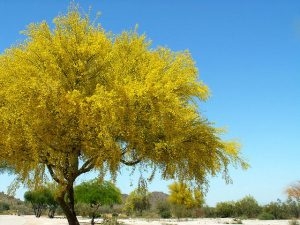
Palo Verde
Tips to Keep Your Garden Soil Healthy
The first week of December is California Healthy Soils Week. To help "celebrate" the occasion, I was asked to give a lecture on some tips to keep your garden soil healthy. If you're the type that likes to watch videos, then you can watch the recording. (It's about 1 hour, including the questions at the end.)
If you're like me and like to get the short, bullet-point version, here it is.
Dustin's Healthy Soil Tips:
- Know your native soil (Try this link!)
- Make permanent paths
- Treat beds like beds: don't stand or walk in them and keep them covered—with mulch
- Add organic materials like compost
- Rotate crops; be sure to include cover crops
- Till gently; here's an article to learn more
Originally published on the Backyard Gardener blog (Dec. 16, 2020):
https://ucanr.edu/blogs/blogcore/postdetail.cfm?postnum=44434





